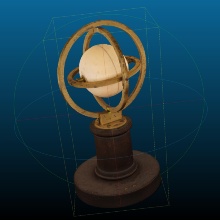Nowadays, gyroscopes can be found almost everywhere: In aviation, on board vessels, in many navigation systems, even in cell phones - and at the University of Stuttgart. In a basement at the Chair of Flight Measuring Technology, you can find one of the most comprehensive collections of scientific gyroscopes in Germany, if not in Europe.
The Stuttgart gyroscope collection and its sub-collections at the Technical University of Munich and the Johannes Kepler University (JKU) of Linz have a long history. The Stuttgart collection was developed and expanded for research and teaching purposes mainly in the 1960s and 1970s by Kurt Magnus, the head of the then Institute of Mechanics, and his co-worker Helmut Sorg. Today, it comprises about 200 objects that have different features and come from various fields of application, such as ship and air navigation. Notable pieces include several LKu 4 directional gyros from Siemens, which were used in World War II in the Ju 88 combat aircraft, among others. Also, there are three classic gyro compasses from the company Anschütz, and components of the Litton LN-3 navigation system, which was installed in the scandal-ridden “Starfighter”. “Gyros are typical dual-use objects,” explains chair holder Prof. Jörg F. Wagner, who has known the collection since he was a young doctoral researcher. “They are prime examples of state-of-the-art development in the field of everyday technologies, but historically they also have considerable military relevance.”
Objects become visible and tangible
Until not so long ago, gyroscopes worked on the principle of the legendary Bohnenberger machine, the so-called gyro with cardanic suspension, which was invented around the year 1810. Since that time, navigation system digitalization has become standard and in many areas, large mechanical gyroscopes are a thing of the past.
However, these historical objects can only be viewed in Stuttgart to a limited extent. There is no suitable room for the sensitive devices, which are also partially painted with a luminous paint that contains radium, which is radioactive. But this is going to change thanks to digitization, and the exhibits will become more accessible and more visible. And you can experience them in a completely different way. “It is our ambition not to show the objects merely as an inanimate whole, but to provide insight into the inner workings of the devices and to show their functionalities,” says Wagner. “The aim is to make the complex devices more tangible digitally.”
Interdisciplinary approach
In order to achieve this goal, the partners of the interdisciplinary project “Gyrolog” combine history of technology, which is a discipline of the humanities, with state-of-the-art methods of photogrammetry and computed tomography, which belong to the engineering sciences. First, the researchers needed photo series of the gyroscopes. The photos were taken and analyzed by Kun Zhan, a member of the project staff. To this end, Zhan placed the exhibits on an inclinable rotary table - using modeling clay and Lego bricks to mount them - and, while rotating the table, took entire series of overlapping pictures. In order to derive 3D points from these image data, the photo blocks are positioned by means of SfM (Structure from Motion), mutually oriented, and then converted into high-quality, colored point clouds. This is done with the software SURE, which was developed at the Institute for Photogrammetry under the then leadership of former Rector Prof. Dieter Fritsch.
CT scans of the inner parts
In order to gain insight into the interior of the devices, they were partially opened. In most cases, however, it was not possible to do this in an adequate way without damaging the devices. This is where Prof. Sven Simon from the Institute of Parallel and Distributed Systems (IPVS) and his co-workers Gasim Mammadov and Timo Schweizer got involved.
Using computed tomography, they produced a large number of high-resolution 2D X-ray images, for which the volume data were then calculated using the institute’s own 3D reconstruction. In addition, the objects are provided with metadata and are semantically enriched to document further data, functional principles, and the use of the exhibits. For this purpose, the scientists employ the software “Goobi”, which is already being used intensively by the University of Stuttgart Library for 2D digitization. Goobi has been extended to map 3D objects especially for Gyrolog.
Links zum Projekt
The question of social acceptance
The dual-use character of gyroscopes in military and civil navigation raises the question of social acceptance under different political conditions, with the historical backgrounds of World War II and the Cold War being of particular importance here. PD Dr. Beate Ceranski and doctoral researcher Maria Niklaus from the Department for the History of Science and Technology at the Institute of History are investigating these historical references. In the process, Niklaus proved to be a credit to the project also for personal reasons: The avid glider pilot knows the history of aviation very well.
By now, about 300 objects have been digitally recorded and can be viewed online. The Gyrolog-platform is published as an open system, so that further digitized material can be added in the future. In addition, an app was developed with which you can explore objects of the collection on a smartphone and even create animations.
The project received very positive feedback from the approx. 80 participants of the online closing conference in January 2021. Prof. Wagner is already thinking one step ahead: “With Gyrolog, we have created a data and method base that can be used for other research collection-related digitization projects,” the scientist is pleased to say. “The German Maritime Museum in Bremerhaven has already made enquiries.”
The project “Gyrolog - Building a digital gyroscope collection for historical and didactic research” has been funded by the Federal Ministry of Education and Research (BMBF) within the framework of the “eHeritage” funding line for 39 months. (Funding code: 01UG1774X).
Contact:
Prof. Dr. Jörg F. Wagner, Chair of Flight Measuring Technology, phone +49 711-685 67046, E-Mail






